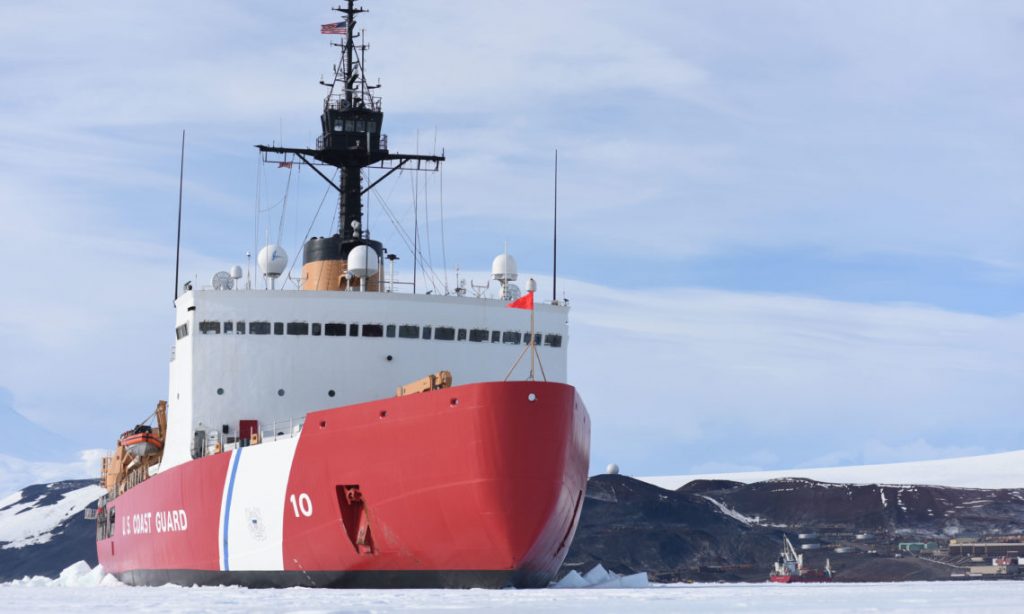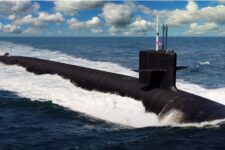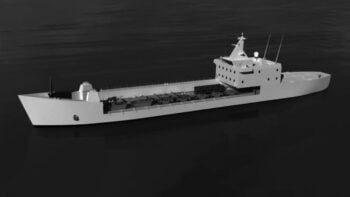
Coast Guard heavy icebreaker Polar Star at McMurdo research station in Anarctica
WASHINGTON: The White House today ordered a major rethink of current plans for a new Coast Guard heavy icebreaker fleet, calling for the ability to launch drones, install intelligence-collection systems, and consider “defensive armament” to “defend against threats by near-peer competitors” and consider the “potential for nuclear-powered propulsion.”
The call to consider new designs for at least three ships already slated to be built over the next half-decade is a sure sign of growing concern in Washington over Russian and Chinese advances in putting more heavy, nuclear-powered ships in the water while the US remains stuck with just two 40 year-old operational breakers. The Coast Guard already has plans for three new, non-nuclear icebreakers to be built by 2026, with several medium icebreakers to follow in later years. It’s not clear if the White House is asking for a complete redesign of those ships, but the memo clearly indicates a desire to expand their capabilities significantly.
The memo gives acting Homeland Security secretary Chad Wolf, in conjunction with the State and Defense departments, just 60 days to come up with a plan to run a study of how to build a new icebreaking fleet that consists of “at least” three heavy polar-class security cutters that are “operationally tested and fully deployable by Fiscal Year 2029.”
The ships should be able to perform “the full range of national and economic security missions (including the facilitation of resource exploration and exploitation and undersea cable laying and maintenance),” the memo states, a clear nod to worries that both China and Russia are rushing to secure natural resources long trapped under the polar ice caps.
The Pentagon and Navy are slated to take part in the snap 60-day assessment, which includes a demand for recommendations for least two new bases in the US, and at least two new international bases.
At least one of those bases would likely be in Alaska, meeting a years-long demand from Alaska Senator Dan Sullivan, who is waiting for the Pentagon to finish a study on a potential strategic port in his state later this summer.
Sullivan managed to get language in the 2020 defense authorization bill ordering the Pentagon to study new ports in Alaska, after years of the military saying there was no need.
“At long last, the federal government has woken up to the fact that the Arctic is a region of great strategic competition,” the senator said in an emailed statement. “Unfortunately, our adversaries are well ahead of the United States when it comes to Arctic infrastructure.” Noting his efforts to bring the Pentagon’s attention to these issues, he added, “this presidential memo will add weight to these efforts and will send a signal to our adversaries and those who are laying claim to the Arctic that the United States will not cede ground in this strategic location.”
Pentagon officials have said privately that refurbishing existing ports in Alaska for military use would be expensive, and they’re not fully convinced there is a need. Sullivan, aware of those arguments, added, “I certainly hope the Pentagon is not going to come back after studying this again, saying there’s no need. The infrastructure is not fine. It doesn’t exist. And we need it to exist.”
One congressional staffer who is familiar with with the issue said part of the problem Arctic advocates have encountered is that “there is no clear official within the Department of Defense that handles Arctic issues,” and despite some efforts on Capitol Hill to create a new deputy assistant secretary of defense for the Arctic, military leaders see the region as “not as high a priority as some other things — the Department of Defense seems to be one of the last federal agencies in the country to understand the strategic importance and relevance of the Arctic.”
While the Coast Guard already has an icebreaker plan in hand, this new White House push might scramble those if the executive branch demands significant changes to the class, the first of which is slated to begin construction in 2021.
As Washington ponders the possibility of building nuclear-powered icebreakers, two Russian companies are already at work building the world’s most powerful nuclear breaker, the first step in an ambitious new Arctic strategy Moscow hopes will open lucrative new shipping routes in the Arctic. The country currently operates 40 icebreakers along the Northern Sea Route in the high north. Moscow has also unveiled plans to build dozens of non-nuclear new icebreakers in the coming years, including at least 13 heavy icebreakers, nine of which would be nuclear-powered, if plans laid out by Russian President Vladimir Putin hold.
For its part, China has already matched the US in the number of icebreakers it has in its fleet, though only one of the two was built domestically. Beijing has expressed a desire to float a nuclear-powered breaker at some point in the future, though plans remain unclear. The first ship, MV Xuelong, was built at a Ukrainian shipyard but has since been upgraded by Chinese shipyards.
‘Mind-boggling’: Israel, Ukraine are mere previews of a much larger Pacific missile war, officials warn
MDA Chief Lt. Gen. Heath Collins said more maneuverable missiles and drones have changed the missile defense game: Instead of just preparing to hit “fastballs,” he said, “now we’re hitting sliders and curveballs.”



























